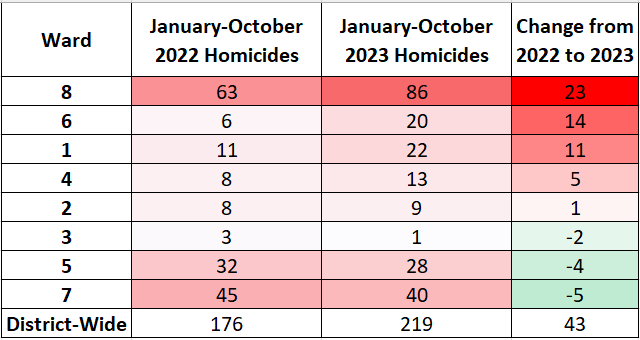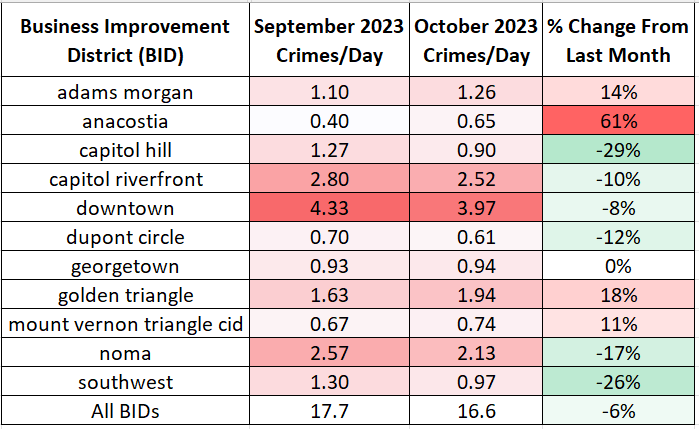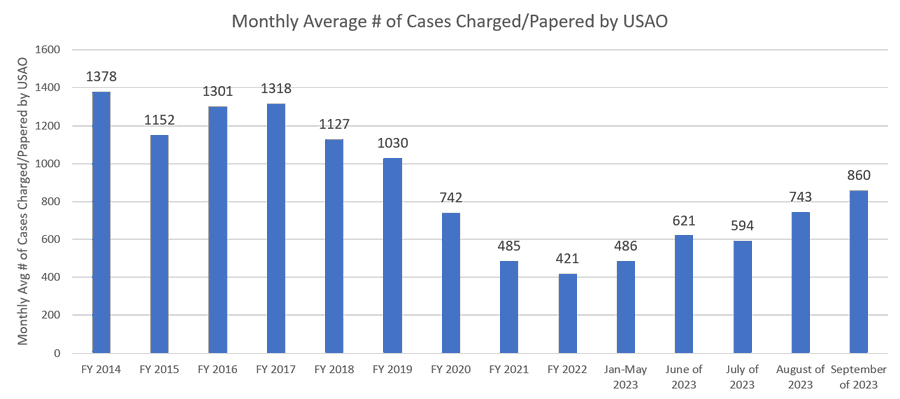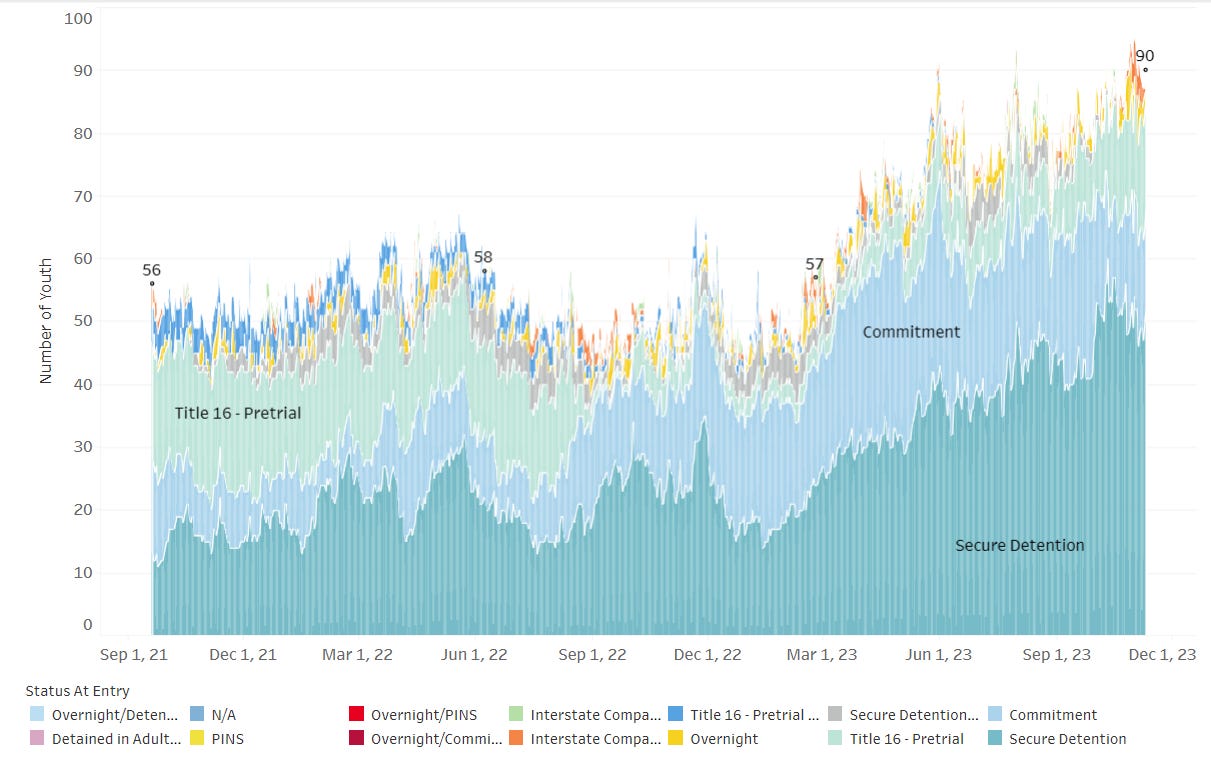Unfortunately crime in DC increased 1% in October. A small 1% decrease among property crimes was counteracted by a 14% increase in violent crimes. This broke 2 months of falling crime rates in August and September after a crime spike in the Summer.
Property crimes were 83% of all crimes and fell 1%; driven by a 7% decrease in theft/other (the most common property crime). Thieves shifted some of their attention to stealing items from cars.
Violent crimes rose 14%, driven by a 17% increase in robbery (the most common violent crime) and a 15% increase in assault with a dangerous weapon (ADW). One bright spot was that homicides fell 37%.
Overall crime is DC is close to the pre-COVID baseline but the mix of crimes has changed since then. Thefts from cars, ADWs and burglaries are down but motor vehicle theft, robbery and homicides are up significantly.
Property crime fell in most wards while increasing in 1 and 4. Violent crime rose in every ward except Ward 8:
October 2023 had 15 homicides, down from 23 in September 2023. There were 21 homicides in October 2022 so this is one of the first months this year where the YTD comparison improved. Wards 7 and 8 represent a disproportionately high 58% of DC’s homicides this year. Unfortunately MPD’s homicide closure rate has fallen to 42%, much lower than previous years where they averaged 62%-70%:
Across DC’s Business Improvement Districts (BIDs) there was an overall 6% decrease in crime but with significant variability:
Looking back over the last 3 years shows property crimes falling somewhat into line with 2021/2022 levels but violent crime rates remaining elevated:
October’s 14% increase in violent crime comes even as it appears that MPD has increased its volume of arrests and the USAO is prosecuting more cases:
The USAO charged 2,197 cases from July-September and they revealed they pressed charges in 53% of the arrests they reviewed in those months. This suggests that they reviewed ~4,145 arrests during that timeframe. The vast majority (but not all) of those arrests would be from MPD; which made 3,510 adult arrests in the previous quarter according to MPD stop data. This suggests that MPD began making significantly more arrests each month after Chief Smith’s nomination in July. Unfortunately because MPD doesn’t release timely arrest data the best we can do is make inferences from these different datasets.
The USAO closed fiscal year 2023 by charging 860 cases in September. This was almost double the 486-per-month pace they set from January to May; before they came under significant media/Congressional pressure. We won’t have October data for another week or so and it will be interesting to see if prosecutions continue to increase:
The relationship between these increases in arrests and prosecutions and the crime rate is complicated. Crime has fallen since the Summer spike but October’s data shows that we aren’t on a steady linear trend towards lower and lower crime rates. There are many factors that impact crime rates and a lot of them come from the broken parts of DC’s justice system that are “downstream” of arrests:
In a follow up to last week’s post about DC’s juvenile detention system; it seems that the Bowser administration is planning to shut down the independent oversight board that has provided valuable data, reports and (mostly unheeded) warnings about staffing levels. The Office of Independent Juvenile Justice Facilities Oversight (OIJJFO) was created when DC finally got out from under a court decree governing its juvenile detention facilities. WAMU/DCist reporter Jenny Gathright described the situation like this on Twitter:
“Both Bowser officials and the head of this agency confirmed to me today that it's indeed going to sunset in early January. The mayoral order establishing the office (at the requirement of the Jerry M. settlement agreement) was always set to expire after 3 years but Executive Director Mark Jordan told me that up until a few weeks ago, he was planning work through the end of the fiscal year because that's what they were budgeted through. Advocates want the office open at least until the city arrives at a permanent oversight solution This is unfolding amid ongoing concern about understaffing and overcrowding at YSC -- which Jordan has raised the alarm about in council hearings over the past couple of years. Jordan's office was also a big reason why this reporting was possible:"
https://dcist.com/story/23/07/21/dc-youth-detention-confinement-staffing-crisis/
This office and its Executive Director Mark Jordan are why we have some of the most informative data and testimony we’ve got about DC’s juvenile detention facilities. They specifically were warning about understaffing as early as 2022; even though that didn’t stop Mayor Bowser or Councilmember Trayon White from cutting DYRS’ budget this year. This effort to roll back oversight is coming at a time when the agency has serious problems that were in the news again after an “emergency pop-up walk-through” by Councilmembers:
The Youth Services Center (YSC) is still over its 88 bed capacity in part due to 16 “commitment” (i.e. post-sentencing) youth being held there instead of more appropriate settings. This useful dashboard from the Office of Independent Juvenile Justice Facilities Oversight shows that “commitment” population in light blue while the pretrial/secure detention population that the YSC is intended for is in shades of green:
In contrast to many parts of DC’s justice system, we actually have some timely data and expert reports about our juvenile detention facilities thanks to the Office of Independent Juvenile Justice Facilities Oversight. It would be a loss for DC if this oversight office is closed without any sort of independent backfill. The executive branch’s own actions and Council oversight have clearly been insufficient.













